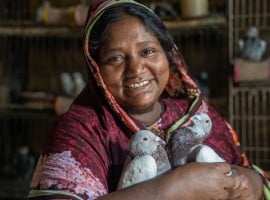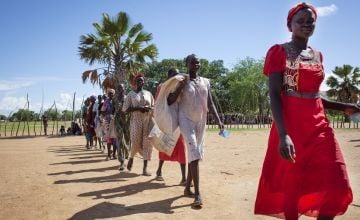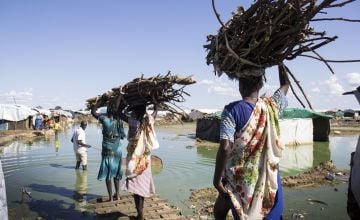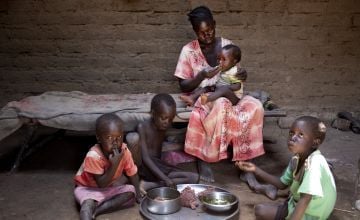
Read our 2024 annual report

Knowledge Hub
After a peaceful secession from Sudan, the Republic of South Sudan became Africa’s 54th country on July 9, 2011. Yet being a new country didn’t absolve South Sudan from the burden of history.
Over two decades of civil war in Sudan led to massive loss of life, destruction, and displacement that impacted the region. This came on top of more than 50 years of conflict and instability in the region, as well as huge development needs.
Despite a peaceful separation, political and economic tensions have persisted. While the country’s rich oil fields have been a source of economic optimism, the impact of conflict and breakdown in services continue to have severe consequences for a country where human development ranks among the worst in the world. In 2022, the country will enter its tenth year of protracted conflict. Here are five things to know about the South Sudan crisis.
South Sudan’s crisis by the numbers
As of 2022, the impact of a protracted crisis in South Sudan has led to:
- 8.3 million people in need of humanitarian assistance
- 2.3 million South Sudanese refugees
- 1.7 million people internally displaced
- 34,000 people living in displacement in protection of civilian (POC) sites
- 1.4 million children suffering malnutrition
- 483,000 women suffering malnutrition
- 809,000 people affected by floods that began in May of 2021
- 12,400 reported cases of COVID-19

1. Conflict has created a domino effect of humanitarian emergencies
Prior to the outbreak of conflict in December 2013, there was reason to be hopeful about the future of South Sudan. Not only had secession been peaceful, but the country was also host to rich oil fields. Many were optimistic that 2013 would be a year of development and progress.
Instead, the conflict - which has led to breakdowns in social services and protection - continues to have severe consequences for a country where human development ranks among the worst in the world.
The conflict in late 2013 rapidly took on an ethnic dimension, displacing over four million South Sudanese. This includes over 34,000 living in overcrowded Protection of Civilian (POC) sites on UN bases. The desperate and immediate needs in these POC sites have been overwhelming, especially as the rapid onset of the crisis required some of the first humanitarian respondents to provide lifesaving services inside a military base - an unlikely combination.
Such violence creates a strong humanitarian need, but also barriers for organisations like Concern to access those who require assistance. In Unity State especially, fighting is common and frequently interrupts programme work for several weeks at a time. For communities already stretched thin on resources and with little to fall back on, these interruptions can have a severe impact.

2. South Sudan is also at the centre of a largely ignored climate crisis
Climate change and conflict are becoming increasingly common bedfellows, and South Sudan is a case study for this relationship. There has been a decrease in rainfall and an increase in temperature in the country, with meteorological data from the last 50 years suggesting an overall increase of roughly 0.5 to 1.5 degrees Celsius. According to UNOCHA, the country ranks as one of the five most vulnerable countries in the world when it comes to the impacts of climate change.
This links with a history of conflicts occurring in the aftermath of floods and droughts within the region, both of which can be attributed to this increase in temperature. Given that both have increased in frequency over the last 60 years, this also means that conflict has increased, largely over competition for increasingly scarce resources like land and water, both of which are essential to a country where 87% of the population depends on agriculture, livestock, and forestry.
The most recent large-scale climate emergency in South Sudan happened last year, with the worst flooding the country has seen in nearly 60 years. This affected eight of the country’s ten states, and over 800,000 people are still dealing with the fallout of a crisis that was largely absent from international news coverage. This lack of action has led relief organisations struggling to get the funding they need to support communities that have lost everything - from homes to infrastructure - to the damage.

3. As of 2022, food insecurity is at an all-time high
The complex balance between conflict and climate has left South Sudan consistently ranking among the world’s hungriest countries as well as one of its largest refugee crises. 'Vast areas of the country are now underwater and food insecurity is at record levels,' UNOCHA reported earlier this month. In 2017, the country suffered a famine.
Now in the wake of floods, renewed violence, and the impacts of COVID-19 shutdowns, part of the country (Northern Bahr el Ghazal and Warrap states) is once again on the brink of seeing a famine declared. According to the International Rescue Committee, 1.7 million people are estimated to be battling emergency levels of hunger across 35 counties. Areas of concern are Jonglei, Unity, Lakes, Warrap, western Pibor and Upper Nile.
Lack of food is also directly related to conflict, serving as both a consequence and a cause of communal violence. Conflict in South Sudan has reduced harvests, which has led to a lack of food. In many cases, this means an increase in poaching and cattle theft, which in turn leads to more conflicts. An economic crisis due to a drop in oil prices and COVID-19 is also contributing to the country’s hunger crisis.

4. South Sudan is one of the worst countries to be a woman
Since independence in 2011, there have been improvements in national policy and laws on gender equality in South Sudan. Many of these recognise the historic inequalities between women and men in the area. However, gender equality and protection concerns remain critical issues.
Gender relations in South Sudan are shaped by both decades of conflict and the related social and economic realities. Prevailing cultural norms, especially in rural areas, leave women excluded from all areas of political activity and decision-making. Early marriage is also common, with 45% of girls married before their 18th birthday (and 7% married before they turned 15). These rates have increased since the start of the conflict.
Social protection also comes with stigmas attached, especially for women affected by gender-based violence, and a recent survey showed that 82% of women and 81% of men agreed that 'women should tolerate domestic violence in order to keep their families together.' Even in a happy marriage, women are at risk in South Sudan, which has one of the highest maternal mortality rates in the world at 14%.
5. Humanitarian responders are doing all the running they can to simply stay in place
As was noted in Concern’s South Sudan programme evaluation in 2017, those involved in the emergency response in the country - including both aid recipients and providers - are 'semi-permanently caught up in a relief phase.' There has been very little room for relief in the last eight years. Despite peace agreements, there is little faith in a political settlement being achieved at a national level. In the meantime, without any other solution, this crisis will continue to absorb significant resources and delay a transition from emergency relief to recovery. One programme respondent summarised it in our 2017 survey:
'If there is no support for the South Sudanese, there will be a country without a population.'
South Sudan: How you can help
Here are some ways that you can take action to help address the crisis in South Sudan:
- Write to your TDs and ask that they continue to honour foreign aid commitments and increase support for South Sudan, prioritising food security and nutrition by funding proven, value-for-money interventions across all relevant sectors.
- Also ask that your TDs increase pressure towards greater protection of humanitarian workers and spaces. We must ensure safe, unhindered humanitarian assistance while continuing to work towards the cessation of hostilities.
- Read, watch, and listen to reportage on South Sudan. Subscribe to the outlets that are providing accurate and ethical reporting on the crisis and, if your outlet of choice is falling behind in their commitment to this topic, write a letter to the editor.
- Finally, you can support organisations like Concern, which have a proven track record in emergency response and navigating complex crises while still achieving results.
Concern in South Sudan
Concern has been in South Sudan since the beginning - and then some. Here are some highlights from last year’s programmes in the country:
- Lifesaving emergency nutrition and health services provided to acutely malnourished children and women, reaching over 142,000 people via 78 nutrition centres.
- Consulted and treated more than 68,000 children and mothers via our mobile clinics in five hard-to-reach areas in Aweil North and West counties, which also provided nutrition sessions for over 90,000.
- Water, sanitation, and hygiene programs reached over 150,000 people in Unity State and Northern Bahr el Ghazal, including 34,000 people living in Bentiu displacement camp.
- Nutrition support and sufficiency for 19,000 people who took part in cash-for-work activities and were also supported with hand tools and improved staple crop seeds.
- Improved water access for 49,000 people as a direct response to COVID-19.

Other ways to help
Corporate support
Is your company interested in working together for a common cause?
Fundraise for Concern
From mountain trekking to marathon running, cake sales to table quizzes, there are lots of ways you can support our work.
Buy a gift
With an extensive range of alternative gifts, we have something to suit everybody.
Leave a gift in your will
Leave the world a better place with a life-changing legacy.
Volunteer with Concern
The lots of ways to get involved with our work as a volunteer
School fundraising
Without the generous support from schools, we wouldn't be able to do the work that we do.


